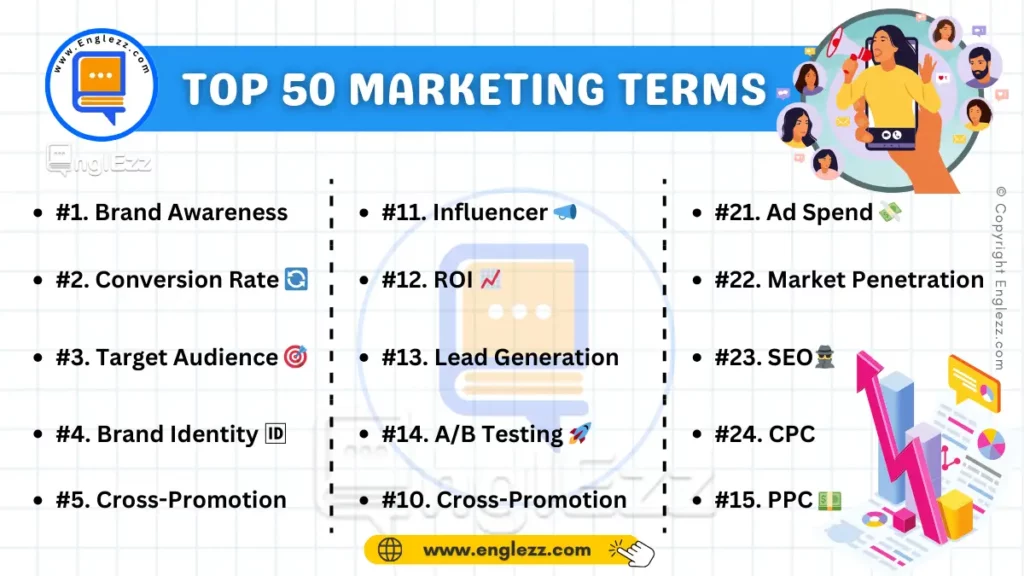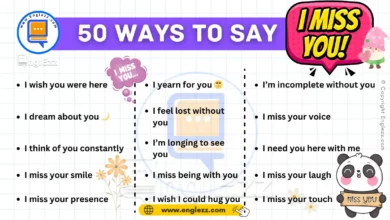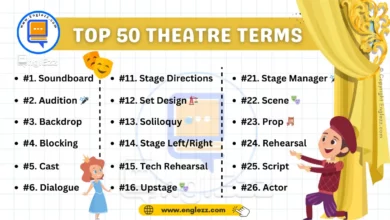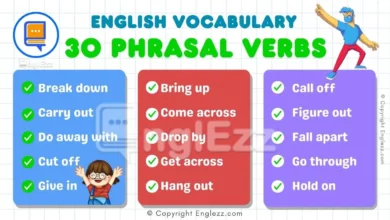Marketing is a dynamic and ever-evolving field, and mastering the language of marketing is crucial for any student aiming to succeed in this industry. This blog post will guide you through 50 essential marketing English terms that every student must know. Each term is explained in detail, with definitions, phonetic transcriptions, and practical examples to help you grasp their usage.
Whether you’re pursuing a degree in marketing, business, or communication, understanding the key terms used in the field will give you a significant advantage.
Table of Contents
- 50 Marketing English Terms Every Student Must Know
- #1. Brand Awareness 🌟
- #2. Conversion Rate 📈
- #3. Customer Acquisition Cost 💰
- #4. Market Segmentation 🎯
- #5. Return on Investment (ROI) 📊
- #6. Lead Generation 🔍
- #7. Digital Marketing 🌐
- #8. Content Marketing ✍️
- #9. Search Engine Optimization (SEO) 🔎
- #10. Influencer Marketing 🌟
- #11. Customer Retention 🛡️
- #12. Branding 🔖
- #13. Market Research 📊
- #14. Email Marketing 📧
- #15. Paid Advertising 💵
- #16. Social Media Marketing 📱
- #17. Customer Journey 🛤️
- #18. Call-to-Action (CTA) 📞
- #19. Market Positioning 📍
- #20. Influencer 📣
- #21. Content Strategy 📋
- #22. A/B Testing 🧪
- #23. Engagement Rate 💬
- #24. Marketing Funnel 📈
- #25. Value Proposition 💡
- #26. Retargeting 🔄
- #27. KPI (Key Performance Indicator) 🎯
- #28. Demographics 📊
- #29. Brand Equity 🌟
- #30. User Experience (UX) 🖥️
- #31. Brand Loyalty ❤️
- #32. Customer Lifetime Value (CLV) 💎
- #33. Market Share 📉
- #34. Competitive Analysis 🔍
- #35. Product Lifecycle ⏳
- #36. Value Chain 🔗
- #37. Public Relations (PR) 📣
- #38. Affiliate Marketing 🤝
- #39. Viral Marketing 🚀
- #40. Campaign Management 🗂️
- #41. Ad Spend 💸
- #42. Market Penetration 🚪
- #43. Brand Identity 🆔
- #44. Positioning Statement 📝
- #45. Cross-Promotion 🔄
- #46. Growth Hacking 🚀
- #47. Omnichannel Marketing 📱🖥️
- #48. Market Trend 📉
- #49. Customer Feedback 🗣️
- #50. Marketing Automation 🤖
- Marketing English Terms Table
- Conclusion
50 Marketing English Terms Every Student Must Know
By familiarizing yourself with these terms, you’ll enhance your vocabulary, improve your comprehension of marketing concepts, and be better prepared for exams and real-world applications. Dive in and equip yourself with the knowledge you need to excel in your marketing studies and future career.
#1. Brand Awareness 🌟
Definition: The extent to which consumers are familiar with the distinctive qualities or image of a particular brand.
Phonetic Transcription: /brænd əˈwɛrnəs/
Examples:
- A successful social media campaign can significantly boost brand awareness among potential customers.
- Companies often measure brand awareness through surveys and focus groups to gauge the effectiveness of their marketing strategies.
#2. Conversion Rate 📈
Definition: The percentage of visitors to a website who complete a desired action, such as making a purchase or signing up for a newsletter.
Phonetic Transcription: /kənˈvɜːrʒən reɪt/
Examples:
- Increasing the conversion rate can be achieved by optimizing the website’s user experience and call-to-action buttons.
- A higher conversion rate indicates that a marketing campaign is effectively driving visitors to take specific actions.
#3. Customer Acquisition Cost 💰
Definition: The cost associated with acquiring a new customer, including marketing and sales expenses.
Phonetic Transcription: /ˈkʌstəmər ˌækwɪˈzɪʃən kɒst/
Examples:
- By analyzing customer acquisition cost, businesses can determine the profitability of their marketing strategies.
- Reducing customer acquisition cost can be achieved by targeting more qualified leads and optimizing advertising spend.

#4. Market Segmentation 🎯
Definition: The process of dividing a broad consumer or business market into sub-groups based on shared characteristics.
Phonetic Transcription: /ˈmɑːrkɪt ˌsɛɡmənˈteɪʃən/
Examples:
- Market segmentation allows companies to tailor their marketing efforts to specific groups, such as age or income level.
- A successful market segmentation strategy helps in creating personalized marketing messages that resonate with different consumer segments.
#5. Return on Investment (ROI) 📊
Definition: A measure of the profitability of an investment, calculated as the ratio of net profit to the cost of the investment.
Phonetic Transcription: /rɪˈtɜːrn ɒn ɪnˈvɛstmənt/
Examples:
- Businesses use ROI to evaluate the effectiveness of their marketing campaigns and make informed decisions about future investments.
- A high ROI indicates that the investment has generated significant returns relative to its cost.
#6. Lead Generation 🔍
Definition: The process of attracting and converting potential customers into leads who are interested in a product or service.
Phonetic Transcription: /liːd ˌdʒɛnəˈreɪʃən/
Examples:
- Effective lead generation strategies include content marketing, social media advertising, and email campaigns.
- Lead generation is essential for building a sales pipeline and increasing the number of potential customers for a business.
#7. Digital Marketing 🌐
Definition: The use of digital channels and technologies to promote products and services and engage with consumers.
Phonetic Transcription: /ˈdɪdʒɪtəl ˈmɑːrkɪtɪŋ/
Examples:
- Digital marketing includes tactics such as SEO, social media marketing, and pay-per-click advertising.
- Businesses leverage digital marketing to reach a global audience and track the performance of their campaigns in real-time.
#8. Content Marketing ✍️
Definition: A marketing strategy focused on creating and distributing valuable, relevant, and consistent content to attract and retain a clearly defined audience.
Phonetic Transcription: /ˈkɒntɛnt ˈmɑːrkɪtɪŋ/
Examples:
- Content marketing can include blog posts, videos, and infographics designed to engage and inform potential customers.
- An effective content marketing strategy helps build brand authority and fosters trust with the audience.
#9. Search Engine Optimization (SEO) 🔎
Definition: The process of improving a website’s visibility and ranking on search engines through various techniques and practices.
Phonetic Transcription: /sɜːrtʃ ˈɛndʒɪn ˌɒptɪˈmeɪʃən/
Examples:
- SEO involves optimizing website content, meta tags, and backlinks to increase organic search traffic.
- Regularly updating and optimizing content is crucial for maintaining high search engine rankings.
#10. Influencer Marketing 🌟
Definition: A form of marketing that involves partnering with influential individuals to promote products or services to their followers.
Phonetic Transcription: /ˈɪnfluənsər ˈmɑːrkɪtɪŋ/
Examples:
- Influencer marketing campaigns often leverage social media personalities to reach target audiences in an authentic way.
- Measuring the success of influencer marketing involves tracking engagement rates and conversions resulting from the partnership.
#11. Customer Retention 🛡️
Definition: The strategies and practices used to keep existing customers engaged and satisfied with a brand or product.
Phonetic Transcription: /ˈkʌstəmər rɪˈtɛnʃən/
Examples:
- Effective customer retention techniques include loyalty programs, personalized communication, and excellent customer service.
- High customer retention rates contribute to long-term business success and increased customer lifetime value.
#12. Branding 🔖
Definition: The process of creating a unique name, design, and identity for a product or company to differentiate it from competitors.
Phonetic Transcription: /ˈbrændɪŋ/
Examples:
- Successful branding involves developing a memorable logo and consistent messaging that resonates with the target audience.
- Strong branding can lead to increased brand loyalty and recognition among consumers.
#13. Market Research 📊
Definition: The process of gathering and analyzing information about consumers, competitors, and market trends to inform business decisions.
Phonetic Transcription: /ˈmɑːrkɪt ˈrɪsɜːrʧ/
Examples:
- Market research helps businesses understand customer needs and preferences, guiding product development and marketing strategies.
- Surveys, focus groups, and data analysis are common methods used in market research.
#14. Email Marketing 📧
Definition: The use of email to send promotional messages and build relationships with potential and existing customers.
Phonetic Transcription: /ˈiːmeɪl ˈmɑːrkɪtɪŋ/
Examples:
- Email marketing campaigns can include newsletters, promotional offers, and personalized messages to engage subscribers.
- Tracking open rates and click-through rates helps measure the effectiveness of email marketing efforts.
#15. Paid Advertising 💵
Definition: A marketing strategy that involves paying for ads to appear on various platforms, such as search engines, social media, or websites.
Phonetic Transcription: /peɪd ˈædvəˌtaɪzɪŋ/
Examples:
- Paid advertising can include pay-per-click (PPC) ads, display ads, and sponsored posts on social media.
- Analyzing the return on investment (ROI) from paid advertising helps optimize ad spend and campaign performance.
#16. Social Media Marketing 📱
Definition: The use of social media platforms to promote products and engage with customers through content and interactions.
Phonetic Transcription: /ˈsəʊʃəl ˈmiːdiə ˈmɑːrkɪtɪŋ/
Examples:
- Social media marketing strategies often involve creating engaging posts, running contests, and interacting with followers.
- Tracking metrics such as likes, shares, and comments helps measure the success of social media campaigns.
#17. Customer Journey 🛤️
Definition: The complete experience a customer has with a brand, from initial awareness through the purchasing process and beyond.
Phonetic Transcription: /ˈkʌstəmər ˈdʒɜːrni/
Examples:
- Mapping the customer journey helps businesses understand pain points and opportunities for improving
the customer experience.
- Enhancing the customer journey can lead to higher satisfaction and increased loyalty.
#18. Call-to-Action (CTA) 📞
Definition: A prompt or instruction designed to encourage the audience to take a specific action, such as clicking a button or signing up for a newsletter.
Phonetic Transcription: /kɔːl tuː ˈækʃən/
Examples:
- Effective CTAs are clear, compelling, and strategically placed on websites or marketing materials.
- Examples of CTAs include “Buy Now,” “Subscribe,” and “Learn More.”
#19. Market Positioning 📍
Definition: The process of establishing a brand or product in a specific place in the minds of consumers relative to competitors.
Phonetic Transcription: /ˈmɑːrkɪt pəˈzɪʃənɪŋ/
Examples:
- Market positioning involves differentiating a brand through unique selling propositions and targeted messaging.
- Successful market positioning helps a brand stand out in a crowded marketplace and attract its target audience.
#20. Influencer 📣
Definition: An individual who has the power to affect the purchasing decisions of others due to their authority, knowledge, position, or relationship with their audience.
Phonetic Transcription: /ˈɪnfluənsər/
Examples:
- Brands often collaborate with influencers to reach new audiences and enhance credibility.
- Influencers can be bloggers, social media personalities, or industry experts who share content that influences their followers’ opinions.
#21. Content Strategy 📋
Definition: A comprehensive plan for creating, delivering, and managing content to achieve specific business goals and engage target audiences.
Phonetic Transcription: /ˈkɒntɛnt ˈstrætədʒi/
Examples:
- A content strategy includes planning content topics, formats, and distribution channels to align with business objectives.
- Regularly reviewing and updating the content strategy ensures it remains relevant and effective.
#22. A/B Testing 🧪
Definition: A method of comparing two versions of a webpage or marketing asset to determine which performs better in terms of user engagement or conversion rates.
Phonetic Transcription: /eɪ biː ˈtɛstɪŋ/
Examples:
- A/B testing can be used to evaluate different headlines, call-to-action buttons, or email subject lines.
- Analyzing the results of A/B testing helps optimize marketing strategies and improve overall performance.
#23. Engagement Rate 💬
Definition: A metric that measures the level of interaction and engagement with content, such as likes, comments, shares, and clicks.
Phonetic Transcription: /ɪnˈɡeɪdʒmənt reɪt/
Examples:
- High engagement rates indicate that content resonates well with the audience and encourages active participation.
- Monitoring engagement rates helps refine content strategies and enhance audience engagement.
#24. Marketing Funnel 📈
Definition: A model that represents the stages a potential customer goes through, from awareness to consideration to purchase and beyond.
Phonetic Transcription: /ˈmɑːrkɪtɪŋ ˈfʌnəl/
Examples:
- Understanding the marketing funnel helps businesses tailor their messaging and strategies to guide customers through each stage.
- Effective marketing funnel management involves optimizing each stage to increase conversions and drive sales.
#25. Value Proposition 💡
Definition: A statement that clearly communicates the unique benefits and value a product or service offers to customers.
Phonetic Transcription: /ˈvæljuː ˌprɒpəˈzɪʃən/
Examples:
- A compelling value proposition addresses customer pain points and highlights how the product or service solves their problems.
- Crafting a strong value proposition is crucial for differentiating a brand from its competitors.
#26. Retargeting 🔄
Definition: A marketing technique that involves targeting ads to users who have previously interacted with a brand but did not complete a desired action.
Phonetic Transcription: /ˈriːˌtɑːrɡɪtɪŋ/
Examples:
- Retargeting ads can remind potential customers of products they viewed but did not purchase.
- Implementing retargeting strategies helps increase conversion rates and re-engage previous visitors.
#27. KPI (Key Performance Indicator) 🎯
Definition: A measurable value used to evaluate the success of a marketing campaign or business objective.
Phonetic Transcription: /ˌkeɪ piː ˈaɪ/
Examples:
- KPIs for marketing might include metrics such as website traffic, conversion rates, or customer acquisition cost.
- Tracking KPIs helps assess the effectiveness of marketing strategies and make data-driven decisions.
#28. Demographics 📊
Definition: Statistical data relating to the population and specific groups within it, such as age, gender, income, and education level.
Phonetic Transcription: /ˌdɛməˈɡræfɪks/
Examples:
- Understanding demographics helps businesses tailor their marketing messages and products to specific audience segments.
- Demographic analysis can inform decisions on targeting and positioning strategies.
#29. Brand Equity 🌟
Definition: The value a brand adds to a product or service, based on consumer perception and loyalty.
Phonetic Transcription: /brænd ˈekwɪti/
Examples:
- Strong brand equity can lead to increased customer trust and higher pricing power.
- Companies often invest in brand-building activities to enhance brand equity and strengthen their market position.
#30. User Experience (UX) 🖥️
Definition: The overall experience a user has when interacting with a product or service, including ease of use, satisfaction, and accessibility.
Phonetic Transcription: /ˈjuːzər ɪkˈspɪəriəns/
Examples:
- Improving user experience involves designing intuitive interfaces and providing seamless interactions.
- Positive user experience can lead to higher customer satisfaction and increased retention rates.
#31. Brand Loyalty ❤️
Definition: The tendency of customers to repeatedly purchase products or services from a brand due to positive experiences and satisfaction.
Phonetic Transcription: /brænd ˈlɔɪəlti/
Examples:
- Brand loyalty is fostered through consistent quality, excellent customer service, and effective loyalty programs.
- Measuring brand loyalty helps businesses understand customer retention and identify opportunities for growth.
#32. Customer Lifetime Value (CLV) 💎
Definition: The total revenue a business can expect from a customer over the entire duration of their relationship.
Phonetic Transcription: /ˈkʌstəmər ˈlaɪftaɪm ˈvæljuː/
Examples:
- Calculating CLV helps businesses assess the long-term value of acquiring and retaining customers.
- Strategies to increase CLV include personalized marketing, upselling, and providing exceptional customer service.
Definition: The portion of a market controlled by a particular company or product, often expressed as a percentage.
Phonetic Transcription: /ˈmɑːrkɪt ʃɛər/
Examples:
- Market share analysis helps businesses understand their competitive position and identify growth opportunities.
- Increasing market share can be achieved through effective marketing strategies, product innovation, and competitive pricing.
#34. Competitive Analysis 🔍
Definition: The process of evaluating and comparing a company’s strengths and weaknesses relative to its competitors.
Phonetic Transcription: /kəmˈpɛtɪtɪv əˈnælɪsɪs/
Examples:
- Competitive analysis involves researching competitors’ products, marketing strategies, and market position.
- Insights gained from competitive analysis can inform strategic decisions and help businesses gain a competitive edge.
#35. Product Lifecycle ⏳
Definition: The stages a product goes through from its introduction to the market to its eventual decline and removal.
Phonetic Transcription: /ˈprɒdʌkt ˈlaɪfsaɪkl/
Examples:
- Understanding the product lifecycle helps businesses plan marketing strategies and manage product updates.
- The product lifecycle includes stages such as introduction, growth, maturity, and decline.
#36. Value Chain 🔗
Definition: A set of activities that a company performs to deliver a valuable product or service to the market.
Phonetic Transcription: /ˈvæljuː ʧeɪn/
Examples:
- Analyzing the value chain helps businesses identify opportunities for cost reduction and value enhancement.
- The value chain includes activities such as production, marketing, and distribution.
#37. Public Relations (PR) 📣
Definition: The practice of managing and influencing a company’s image and reputation through communication and media relations.
Phonetic Transcription: /ˈpʌblɪk rɪˈleɪʃənz/
Examples:
- PR strategies can include press releases, media interviews, and event management to build positive relationships with the public.
- Effective PR helps manage brand perception and address any negative publicity.
#38. Affiliate Marketing 🤝
Definition: A performance-based marketing strategy where businesses reward affiliates for driving traffic or sales through their referral links.
Phonetic Transcription: /əˈfɪlɪeɪt ˈmɑːrkɪtɪŋ/
Examples:
- Affiliate marketing programs can include partnerships with bloggers, influencers, or other businesses to promote products.
- Tracking affiliate performance helps optimize commissions and ensure successful collaborations.
#39. Viral Marketing 🚀
Definition: A marketing technique that encourages individuals to share content rapidly, resulting in exponential growth in reach and visibility.
Phonetic Transcription: /ˈvaɪrəl ˈmɑːrkɪtɪŋ/
Examples:
- Viral marketing campaigns often leverage compelling or entertaining content to encourage social sharing.
- Measuring the success of viral marketing involves tracking the number of shares, views, and overall engagement.
#40. Campaign Management 🗂️
Definition: The process of planning, executing, and monitoring marketing campaigns to achieve specific objectives and measure their effectiveness.
Phonetic Transcription: /kæmˈpeɪn ˈmænɪdʒmənt/
Examples:
- Effective campaign management includes setting goals, budgeting, and analyzing performance metrics.
- Monitoring campaign progress helps adjust strategies and ensure optimal results.
#41. Ad Spend 💸
Definition: The amount of money allocated to advertising and promotional activities within a specific period.
Phonetic Transcription: /æd spɛnd/
Examples:
- Tracking ad spend helps businesses allocate resources effectively and measure the return on investment.
- Optimizing ad spend involves analyzing campaign performance and adjusting budgets to maximize impact.
#42. Market Penetration 🚪
Definition: The strategy of increasing a product’s or service’s market share within an existing market.
Phonetic Transcription: /ˈmɑːrkɪt ˌpɛnəˈtreɪʃən/
Examples:
- Market penetration can be achieved through aggressive pricing, promotional offers, or expanded distribution channels.
- Measuring market penetration helps assess the success of strategies aimed at growing market share.
#43. Brand Identity 🆔
Definition: The visible elements of a brand, such as its logo, colors, and typography, that convey its personality and values.
Phonetic Transcription: /brænd aɪˈdɛntɪti/
Examples:
- Developing a strong brand identity helps create a memorable and recognizable image in the minds of consumers.
- Consistent use of brand identity elements across marketing materials strengthens brand recognition.
#44. Positioning Statement 📝
Definition: A concise statement that defines how a brand or product is positioned in the market and how it differs from competitors.
Phonetic Transcription: /pəˈzɪʃənɪŋ ˈsteɪtmənt/
Examples:
- A clear positioning statement helps guide marketing strategies and ensure consistent messaging.
- An effective positioning statement highlights the unique value proposition and target audience.
#45. Cross-Promotion 🔄
Definition: A marketing strategy that involves promoting a product or service through partnerships with other brands or products.
Phonetic Transcription: /krɒs prəˈməʊʃən/
Examples:
- Cross-promotion can include joint marketing campaigns, co-branded products, or mutual endorsements.
- Leveraging cross-promotion helps reach new audiences and enhance brand visibility.
#46. Growth Hacking 🚀
Definition: A marketing technique focused on rapid experimentation and innovative strategies to achieve growth and scalability.
Phonetic Transcription: /ɡrəʊθ ˈhækɪŋ/
Examples:
- Growth hacking often involves unconventional tactics, such as viral marketing or product tweaks, to drive growth.
- Analyzing the results of growth hacking efforts helps refine strategies and accelerate progress.
#47. Omnichannel Marketing 📱🖥️
Definition: A marketing approach that provides a seamless and integrated customer experience across multiple channels and touchpoints.
Phonetic Transcription: /ˌɒmnɪˈtʃænəl ˈmɑːrkɪtɪŋ/
Examples:
- Omnichannel marketing ensures that customers receive consistent messaging and service whether they interact online, in-store, or through mobile apps.
- Implementing omnichannel strategies helps enhance customer satisfaction and loyalty.
#48. Market Trend 📉
Definition: A general direction in which the market or industry is moving, based on emerging patterns and consumer behaviors.
Phonetic Transcription: /ˈmɑːrkɪt trɛnd/
Examples:
- Identifying market trends helps businesses stay ahead of changes and adapt their strategies accordingly.
- Analyzing market trends can provide insights into consumer preferences and competitive dynamics.
#49. Customer Feedback 🗣️
Definition: Information provided by customers about their experiences with a product or service, used to improve quality and satisfaction.
Phonetic Transcription: /ˈkʌstəmər ˈfiːdbæk/
Examples:
- Gathering customer feedback through surveys or reviews helps identify areas for improvement and enhance product offerings.
- Analyzing feedback trends can guide strategic decisions and drive customer-centric changes.
#50. Marketing Automation 🤖
Definition: The use of technology to automate repetitive marketing tasks, such as email campaigns and social media posts, to improve efficiency and effectiveness.
Phonetic Transcription: /ˈmɑːrkɪtɪŋ ˌɔːtəˈmeɪʃən/
Examples:
- Marketing automation tools can streamline processes such as lead nurturing and customer segmentation.
- Implementing marketing automation helps businesses manage campaigns more efficiently and deliver personalized experiences.
Marketing English Terms Table
| #1. Brand Awareness 🧠 | #11. Influencer 📣 | #21. Ad Spend 💸 |
| #2. Conversion Rate 🔄 | #12. ROI (Return on Investment) 📈 | #22. Market Penetration 🚪 |
| #3. Target Audience 🎯 | #13. Lead Generation 🚀 | #23. Brand Identity 🆔 |
| #4. SEO (Search Engine Optimization) 🕵️ | #14. Content Marketing 📝 | #24. Positioning Statement 📝 |
| #5. PPC (Pay-Per-Click) 💵 | #15. Social Media Marketing 📱 | #25. Cross-Promotion 🔄 |
| #6. Engagement Rate 💬 | #16. Email Marketing 📧 | #26. Growth Hacking 🚀 |
| #7. CRM (Customer Relationship Management) 🗂️ | #17. Call-to-Action (CTA) 📞 | #27. Omnichannel Marketing 📱🖥️ |
| #8. Market Positioning 📍 | #18. Brand Loyalty ❤️ | #28. Market Trend 📉 |
| #9. Content Strategy 📋 | #19. A/B Testing 🧪 | #29. Customer Feedback 🗣️ |
| #10. KPI (Key Performance Indicator) 🎯 | #20. User Experience (UX) 🖥️ | #30. Marketing Automation 🤖 |
Conclusion
Understanding and mastering marketing English terms is essential for students looking to excel in their marketing studies and careers. This comprehensive guide has provided you with 50 crucial marketing terms, complete with definitions, phonetic transcriptions, and practical examples.
By familiarizing yourself with these terms, you’ll not only enhance your vocabulary but also gain a deeper understanding of key marketing concepts and strategies. Whether you’re preparing for exams or diving into the professional world, this knowledge will serve as a valuable asset.
Stay ahead in the competitive field of marketing by continuously expanding your expertise and applying these terms in real-world scenarios.
Remember, effective communication and a solid grasp of marketing terminology are fundamental to your success in this dynamic industry.









Discover the top 50 marketing English terms every student must know! 🚀 Enhance your marketing vocabulary with clear definitions and practical examples. 🌟Follow and like @EnglEzz for more insightful posts! 🔗
.
https://www.englezz.com/50-essential-marketing-english-terms/
.
#englezz #vocabulary #linguistics #marketingtips #studentlife #digitalmarketing #brandstrategy #contentcreation #SEO
Wonderful website Lots of useful info here I’m sending it to a few friends and additionally sharing in delicious And obviously thanks to your effort